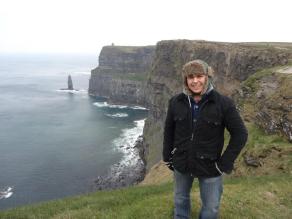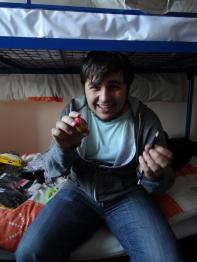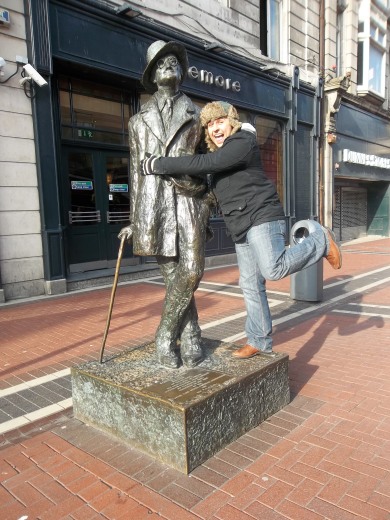A Journey Through Ireland: The Cliffs of Moher, Blarney Castle and Dublin
However exhausted I was from the trip through Scotland, I’d never sprung out of bed with more enthusiasm than the day I left with my trusty Australian buddies to road trip through the South of Ireland. It didn’t hurt, I suppose, that I was able to sleep in until 10:30 this time.
Scotland was beautiful from the majesty of its mountainous scenery and camera-surpassing landscape, and yet I preferred the navigating the country roads of Ireland to the mountainous ones of the Highlands. There was a sort of simple, rustic beauty to it—a beauty that the exaggerated portrayals of cheesy American films that take place in Ireland really don’t even do justice to. Sheep and cows grazed in pack behind makeshift stone walls that stretched for miles with an occasional interruption in the form of a lone tree or some overgrown, unrecognizable ruins. The cows munched on hay desperately, as if it were in danger of going somewhere; the sheep were much more passive. It was impossible to say if their passivity contributed to the scenery or was a result of it.
Our first stop on the trek across Ireland was in the city of Galway. We didn’t arrive until later in the night, and although the drive had been a pleasant one with all kinds of unimaginable countryside scenery, we were exhausted. Quirky little shops and pubs lined the streets—unfortunately, most of the non-nightlife cultural aspects of the city were shut down for the night and we were leaving in the morning, but I could tell I would have loved the opportunity to wander this city’s exciting streets. We hit an additional bit of bad luck with our hostel on that night—the shower and bedroom conditions were less than desirable. In a strange way, though, the generally poor conditions of the hostels we stayed at were a welcome factor of traveling—it isn’t about staying in luxury, it’s about getting on the road. Getting too comfortable isn’t conducive to getting out and actually experiencing what you came to see.
We hit the road again, this time to head to the Cliffs of Moher. We’d seen all kinds of ruins on the roadside so far: crumbling ruins of old  cottages, frameworks of barns and even some larger buildings. But they began to appear in increasing frequencies as we headed deeper into the countryside, sheep milling about the moss-strewn ruins as if their presence was as natural as the rocks or the trees. With a relatively inactive first day on the road behind us, our eagerness to reach the famed cliffs kept us in the car but we knew without words to one another that we had stop at Dunguaire Castle and the almost entirely complete ruins of a farmhouse that neighbored it. Dunguaire Castle sits comfortably on the edge of a very scenic portion of Galway Bay. The entire building is overgrown in moss and ivy and all of the buildings within eyesight of it have traditional Irish thatched roofs—whether or not this was natural or to meet the expectations of tourists, I don’t know, but it was beautiful nonetheless. I tried not to spend too much time contributing to the old castle’s reputation as the photographed castle in Ireland and walked around its perimeter in circles, continuously appreciating the view of Galway Bay when I came around to it. Evan, one of my Australian friends, and I were the only two curious enough to explore the ruins of the nearby farmhouse. The framework and chimney of the house were still standing, even if they were beginning to crumble a bit, and tools were scattered across the floor. It was amazing to think that this was someone’s actual home at a point and the land and structure had passed into something that was simply there—a rented home for a person living a rented life. I couldn’t help but wish at that moment that ruins weren’t considered eyesores in America.
cottages, frameworks of barns and even some larger buildings. But they began to appear in increasing frequencies as we headed deeper into the countryside, sheep milling about the moss-strewn ruins as if their presence was as natural as the rocks or the trees. With a relatively inactive first day on the road behind us, our eagerness to reach the famed cliffs kept us in the car but we knew without words to one another that we had stop at Dunguaire Castle and the almost entirely complete ruins of a farmhouse that neighbored it. Dunguaire Castle sits comfortably on the edge of a very scenic portion of Galway Bay. The entire building is overgrown in moss and ivy and all of the buildings within eyesight of it have traditional Irish thatched roofs—whether or not this was natural or to meet the expectations of tourists, I don’t know, but it was beautiful nonetheless. I tried not to spend too much time contributing to the old castle’s reputation as the photographed castle in Ireland and walked around its perimeter in circles, continuously appreciating the view of Galway Bay when I came around to it. Evan, one of my Australian friends, and I were the only two curious enough to explore the ruins of the nearby farmhouse. The framework and chimney of the house were still standing, even if they were beginning to crumble a bit, and tools were scattered across the floor. It was amazing to think that this was someone’s actual home at a point and the land and structure had passed into something that was simply there—a rented home for a person living a rented life. I couldn’t help but wish at that moment that ruins weren’t considered eyesores in America.
It wouldn’t be fair to expect words or camera-taken pictures to describe the ancient power of the Cliffs of Moher, but unfortunately I only have the two to work with. To put it into perspective, I knew as soon as I glimpsed the beginning of the Cliffs that I would not have any doubts that I hadn’t “done enough” while I was studying abroad. They seemed to stretch on for miles (and probably did), their immense height making them seem almost unreal, like a painting that would serve as a backdrop in an old Western film. Children and instigating boyfriends posed tauntingly close to the edges of the cliffs, prompting their respective mothers and girlfriends to deal immediate scoldings. They might have had good reason, as the “guard rails” were usually just tiny fences in the spots of the clifftop walkway where they actually were present. To me, however, it was refreshing to not see a ridiculous amount of legally obligated lawsuit-fearing precautions taken. It seems so much more natural to simply look over the edge and see a sudden stop and an unimaginable drop, seagulls nesting casually in the small nooks in the cliff wall. I was glad that my friends were as entranced as I was this time—it was the kind of place that’s difficult to walk away from.
We traveled onwards to Cork, where we booked into our hostel cooked a meal in its kitchen. It was something we were all very excited for—a person can only eat out so many times before their budget and stomach start complaining together. After a somewhat bizarre night in which the threat of one of my rechargeable camera batteries gave signs that it was going to explode alarmed our company (and our poor and unprepared Polish and French roommates), we set off for Blarney Castle, home of the infamous Blarney Stone.
I had an image of the Blarney Stone that I think it’s safe to assume most Americans share: a medium-sized boulder resting quietly in a sun-drenched and isolated Irish glen. I’d always heard that you had to bend over backwards to kiss it, but I always assumed that this was just some sort of folkloric condition that had evolved over the years. The assumptions I’d inherited couldn’t have been more wrong. The Blarney stone is a small stone built into the bottom parts of the battlements on the very top of Blarney Castle. There is a (roughly) 5 foot drop between the castle floor and the stone in which the only barrier between the kisser’s body and the ground, hundreds of feet below, are two thin iron bars. The kisser has to bend backwards because there is literally no other way to kiss the Blarney Stone other than grabbing onto two railings and leaning backwards and upside-down.
“Has anyone ever died doing this?” asked my nervous friend Jocelle.
“Yes,” replied the man overseeing the line. “Now go on and kiss it.”
My turn to kiss the stone came much too fast, and ended just as quickly. As I was hanging upside down, stretching my neck to reach the stone, I thought of my Irish grandmother who is currently living in a nursing home with Alzheimer’s. I’m fully prepared to say that the idea of an “Irish-American” or any kind of hyphenated American is a myth after traveling here—unless, of course, you have a genuine connection to the land. But my grandma is the real deal. She’d be happy to know that I kissed the Blarney Stone because she never got the chance to come to Ireland. I wouldn’t have either if I hadn’t gotten the education I did which wouldn’t have been possible without the lessons I received from my Mother which were in turn inherited from her parents. I owed her a kiss to the Blarney Stone.
It was onward to Dublin next for a final night before our return journey. Having spent enough time in the North of Ireland and a reasonable bit of time in the South, I’ve learned that the real experience isn’t just in the “main attractions”, so to speak, that draw in tourists. To really experience Ireland a traveler has to actually participate in the culture, the good times or the “craic” as locals would call it. Though it has touristy potential, the Temple Bar District of Dublin is the perfect place to find some  craic. In fact, it would be difficult not to find it there.
craic. In fact, it would be difficult not to find it there.
Almost every building in the cobblestoned sector is a pub, and yet, we were having a tough time trying to find a place to have a pint and a square meal because of the sheer amount of people that haunt the Temple Bar area once the sun goes down. We finally managed to find a place called the “Busker’s Bar” with live music and a solid looking menu. We were unsurprisingly satisfied with what we found. For my last night in the South it was only fitting that I order a local favorite “bangers n’ mash” as the folks in Ireland call it, which is usually just a set of thick locally made sausages rested on a bed of mashed potatoes. The meal was served with a small loaf of Guinness made brown bread—yes, Guinness is a totally acceptable baking ingredient.
But my real “experience”, the actual moment where I felt like I was personally experiencing Dublin, and Ireland as a whole for that matter, came afterwards. My Australian friends were dying for a hot chocolate and slipped into a café in the Temple Bar area; I was in a bit of a pensive mood (and a bit broke) so I opted to stand outside and listen to a bunch of rowdy looking buskers playing to a small crowd that had begun to crowd around them. The band, “Mutefish”, had six or seven twenty-somethings sporting wild, long hair and thick woolen sweaters, the front man with a confident and mischievous glint in his eye as he played away on the tin whistle as the crowd around him danced and grew. I’d seen other musicians all over the streets of Dublin and Belfast, some of them who actually seemed to be making a decent profit. The difference here had nothing to do with the money though. These guys were genuinely enjoying the craic; they loved every minute of the ability to just set up shop on a streetside and play some boisterous Irish music to a crowd of strangers and friends alike. I was watching entirely alone and felt perfectly comfortable, as if I’d known every excited face in the crowd and we’d all previously agreed to meet up here.
I didn’t bother taking an impulsive video like the crowds around me because I knew something this unique had to have found a home on the internet. Dozens of their spontaneous shows are on Youtube and similar sites:
I would have reflected more on the trip during the car ride back if few enough things had happened for me to focus on. But I was exhausted. The only image I could really focus on was the statue of James Joyce on one of the main streets of Dublin. I had sought it out purposely, as I’m reading Joyce right now, and have always had an immense amount of respect for his mastery of complicated narrative structures. It occurred to me, when I saw him standing there with a confident, clever sort of grin on his statuesque face as if he knew a secret and was holding above the heads of all his curious party guests: he had probably stood here, on this exact street corner, where his own statue would one day be erected and young writers, Joyce’s “second selves” as Wordsworth would put it, would come just to take a picture with his concrete likeness. It was clear in so many ways that the place and the people in it are permanently intertwined, even if they should be separated by death, distance or anything in between.




 Facebook
Facebook Twitter
Twitter YouTube
YouTube
Reblogged this on Literally Literary.